
Frontier Airlines
TIMETABLES
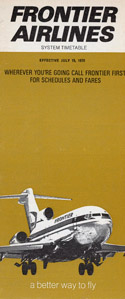 July 1970
July 1970
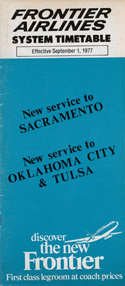 September
1977
September
1977
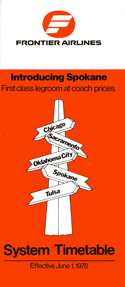 June
1978
June
1978
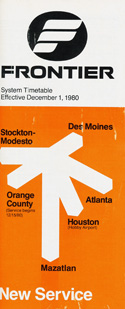 December
1980
December
1980
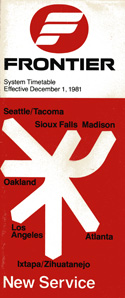 December
1981
December
1981
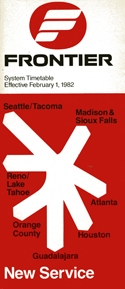 February
1982
February
1982
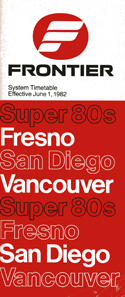 June
1982
June
1982
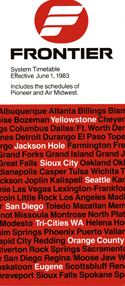 June
1983
June
1983
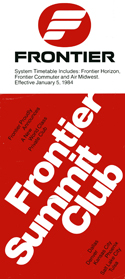 January
1984
January
1984
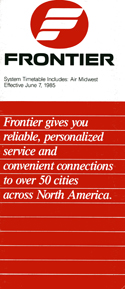 June
1985
June
1985
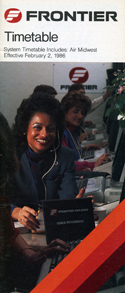 February
1986
February
1986
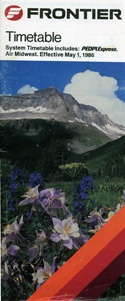 May
1986
May
1986
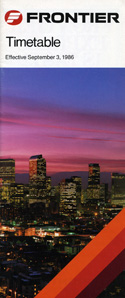 September
1986
September
1986
Frontier Airlines (FL) was the result of a
merger between three “feeder” carriers; Arizona Airways,
Challenger Airlines, and Monarch Air Lines on June 1, 1950.
Arizona Airways: Originally founded as a pilot
training school in September 1942 by H.O. “Rocky” Nelson in
Safford, Arizona to provide pilots for the war effort. At the conclusion
of World War II, Arizona Airways was moved to Phoenix, Arizona to
provide passenger service to points within Arizona and focusing on
scenic flights to Grand Canyon. Arizona Airways started scheduled
passenger operations on March 17, 1946 using a seventeen seat
war-surplus Douglas C-47 on a circular route to Tucson then to five
other stops before returning to Phoenix. On April 7, 1946 the
Phoenix-Prescott-Grand Canyon route was started as well as a flight west
from Phoenix to Yuma. Over the next six months the airline acquired two
additional Douglas C-47 and added service to six additional intrastate
destinations including Tucson, Kingman, and Yuma. During this time,
Arizona Airways was operating without a Civil Aeronautics Board (CAB)
certificate and applied for an airmail contract between Phoenix and El
Paso. The CAB issued a certificate in January 1948, however by this time
the small carrier was in financial despair. With no reservations
systems, unsubsidized routes, and restrictions on the popular
Phoenix-Tucson route, Arizona Airways was struggling. On March 1, 1948
all Arizona Airways flights were halted due to the financial condition.
There was a discussion of a possible merger with Bonanza Air Lines
however that feel through and the Douglas C-47 sat on the ramp in
Phoenix unused. In 1949, Denver based Monarch Air Lines looked south and
merged with Arizona Airways with CAB approval on April 10, 1950.
Challenger Airlines: Started operations as Summit Airways in December 1941, a Fixed Base Operator (FBO) in Laramie, Wyoming. An application for air transport in Wyoming was sought via the CAB in 1944, however the owner of Summit Charles W. Hirsig was killed in an airplane accident in January 1945. The assets of Summit were purchased by Fred M. Manning and the CAB awarded a temporary operating certificate on March 28, 1946. A few states over in Utah, George W. Snyder Jr. started Challenger Airlines to provide intrastate Utah service and an interstate route between Salt Lake City and Phoenix in March 1946, using a Beech Model D-18. Snyder didn’t have a certificate and the CAB shut down his interstate Phoenix service quickly. Knowing the carrier would have a hard time financially surviving without government mail subsidy, Snyder purchased the approved CAB certificate from Summit Airways in January 1947. Keeping the Challenger Airlines name, Snyder purchased four Douglas DC-3 and flights commenced on May 3, 1947 on a multi-stop Salt Lake City-Denver route. By July 1947, service was extended to Billings, Montana via points in Wyoming. Within two months, Challenger Airlines was flying to sixteen cities within the states of Utah, Colorado, Wyoming, and Montana. In April 1948, Challenger Airlines moved its headquarters to Denver, Colorado and started to share maintenance activities with neighboring carrier Monarch Air Lines. Considering the two carriers both based in Denver, started to combine schedules and operating activities. In December 1949, the CAB approved the merger between Challenger Airlines and Monarch Air Lines.
Monarch Air Lines: Based in Denver, Colorado
started passenger operations on November 27, 1946 with a flight from
Denver to Durango using a Douglas DC-3. Ray Wilson started a flight
school in Denver in the 1940s, and applied to the CAB for scheduled
passenger service from Denver to Salt Lake City and Albuquerque, New
Mexico. The CAB approved the application under Monarch Air Lines, named
after the Monarch Pass in June 1946. Monarch pioneered passenger service
to some of the more remote, and rugged destinations within Colorado
including Durango, Pueblo, and Canon City. In January 1947 flights
extended to both Albuquerque and Salt Lake City via Denver with many
intermediate stops in between. Although the feeder had marginal load
factors, it was hauling much freight however losing money in the
process. In 1948, things started to stabilize a bit financially for the
carrier, and saw an opportunity to share maintenance expanses with
recently relocated Challenger Airlines at Denver. Within a year both
carriers were almost operating as one and a merger was approved by the
CAB in December 1949. During that same time, Monarch Air Lines sought to
purchase the remaining assets and aircraft of Arizona Airways so a
three-way merger of the three feeder carriers was set to take place in
early 1950.
Frontier Airlines: With the merger of both
Monarch Air Lines and Challenger Airlines approved by the CAB in
December 1949, and the merger of Monarch Air Lines and Arizona Airways
in April 1950, the combined operation of all three carriers would cause
potential financial instability and confusion and an application with
the CAB was filed for consolidation of the three feeder carriers into
one, to become known as Frontier Airlines. The CAB approved the merger
on May 15, 1950, and on June 1, 1950 Frontier Airlines inaugurated
service on the combined routes of the former three airlines.
The name Frontier was
fitting considered the airline would serve
a large portion of the Mountain West that
formed the edge of the settled part of the country, a term straight from
the dictionary. The new airline initially would operate twelve Douglas
DC-3s acquired through the merger and fly to forty-seven destinations
across seven states, stretching south from Denver to Albuquerque, El
Paso, and Douglas, Arizona, north to Billings, Montana and West to Salt
Lake City. Within a year, Frontier had flown 138,000 passengers, however
realized that most of its revenue was the result of carrying mail and
air freight.
In 1954, Frontier applied to the CAB for service
into North Dakota and intermediate points seeing an opportunity to serve
the growing oil industry in the upper western plains. The CAB approved
the Williston Case and Frontier started service on September 15, 1954
between Billings, Montana and Bismarck, North Dakota via six
intermediate stops. By 1955, Frontier had trimmed its schedule down to
forty destinations across the Rocky Mountain region and received
permanent CAB certificates to know operate as a “local service carrier”
one of thirteen authorized to do so in the United States. With the
Douglas DC-3s getting older and passengers wanting a more comfortable
experience especially across the sometime turbulent Rockies, Frontier
placed an order for six Fairchild F-27 turboprops in 1956 with the first
two scheduled for delivery in 1958.
Another windfall came to Frontier in 1958 with
the award of twenty-seven new cities as part of the CAB Seven States
Case. This included new routes from St. Louis, Missouri, through points
in Nebraska to Denver and from Bismarck to Denver via points in South
Dakota and Wyoming. With the increase in service and the rapid
expansion, Frontier sought a cheaper option then the Fairchild F-27s
that had been ordered. The Fairchild also had limitations on its
performance, specifically from high altitude airports that Frontier was
used to operating from in the Rocky Mountain region. A fleet of five, second-hand Convair CV-340s were purchased from United Air Lines, and were both
pressurized and radar equipped with a cruise speed of 275-miles per
hour. The new planes were placed into service on July 1, 1959 and would
provide “Frontiersman” service for up to forty-four passengers. The new
planes wearing a new color scheme, initially started service on the
Albuquerque-Salt Lake City route via Denver and intermediate points and
between Denver and Omaha.
Frontier Airlines entered the 1960s as a strong,
regional carrier. In early 1960, the airline was flying to sixty-eight
cities across eleven states using both the Douglas DC-3 and Convair
CV-340 with over 500,000 passengers boarding that year. Having been
pleased with the Convair product, Frontier looked to add true “jet”
aircraft to its fleet and actually signed an intent to purchase six of
the British Aerospace BAC-1-11 for delivery in 1965. Airframe costs and
production delays had Frontier cancel the BAC-1-11 aircraft and instead
partner with General Motors-Allison division to convert the existing
fleet of sixteen Convair CV-340s to “jet” turboprop standard starting in
January 1964. The first Conavir CV-580 as the new conversion was called
took to the skies in passenger service on June 1, 1964 initially placed
on the multi-stop Billings, Montana to El Paso, Texas route. The new
planes had a capacity of fifty-two passengers and a cruise speed of
355-miles-per-hour making lowering trip times and providing smoother
service and becoming the first airline in the world to put the Convair
CV-580 in service.
Keeping true jet service in mind, Frontier took
the bold step of placing an order for five Boeing 727s with an option
for five additional aircraft in August 1965, for delivery to start in
January 1967. The new plane was expected to be used on denser route
segments, and planned service to both New Orleans and Seattle. Frontier
received its first Boeing 727-100 on September 8, 1966, with scheduled
service starting on September 30, 1966 on a Denver-Lincoln-Kansas City
route. The new Boeing 727-100 had seating for ninety-six passengers in a
first/coach cabin configuration and were affectionately known as
“Arrowjets.” With the introduction of the Boeing 727, Frontier’s route
system was now covering seventy cities across eleven states.
On October 1, 1967 Frontier Airlines purchased
neighboring local service carrier, Central Airlines based in Fort Worth,
Texas. Central Airlines had started operations in 1944, as charter
operator before receiving an air operator certificate and starting
scheduled flights in September 1949. Central, like the other local
service carriers, expanded across its region, covering Texas, Kansas,
Oklahoma, and Missouri. There was some overlap with Frontier into
Colorado, which peaked the interest of their Denver, based carrier after
a merger between Ozark Air Lines and Central failed. After some
negotiation, the CAB approved a purchase of Central Airlines by Frontier,
which added forty cities across six Midwest states and a fleet of eleven
Convair CV-600s and sixteen Douglas DC-3s.
The Boeing 727s brought new comfort and speed to
Frontier passengers, and with the continued introduction of the
converted Convair CV-580, the Douglas DC-3s were considered “old”
technology next to the newer jet powered equipment. The Douglas DC-3 did
have its use in continuing to provide service to those few airports in
the system that were not big enough for the Convair CV-580. This
included Havre, Wolf Point and Glasgow in Montana and Chadron and
Alliance, Nebraska. Boeing 727-200 “Stretch” aircraft started to be
delivered to Frontier in February 1968 with increased capacity and were
initially placed on routes from Denver to Las Vegas and St. Louis. With
the delivery of the new 727s, management started to look at the
operating costs and economics of the TriJet. Boeing had just announced
the Boeing 737 “Twin-Jet” and Frontier saw two engines, and just two
cockpit crew as an answer to the shorter route segments across its
network. An agreement was made with Boring to “trade” five of the Boeing
727-100s for five new Boeing 737-200s for delivery in 1969.
With more Convair 580s joining the fleet and the
Boeing 727s, Frontier made the decision to retire the aging Douglas
DC-3s from service on October 23, 1968. With the retirement of the DC-3s
some cities were left without air service in both Kansas and Montana
because the airport facilities couldn’t handle the larger Convair 580. These
routes were dropped until Frontier made the decision to acquire the
19-passenger de Havilland DHC-6 Twin Otter, which would be a perfect fit
for the smaller, Essential Air Service (EAS) communities and started service
in October 26, 1970, between Great Falls and Williston with intermediate
points. A year later Frontier started “commuter” service by replacing
certain Convair CV-580 routes in Kansas with two new Beech B-99
turboprops. Flights with the B-99 started on March 1, 1971 from a
Scottsbluff, Nebraska base. The use of the Beech B-99s only lasted about a year
when they were replaced by Twin Otters in October 1972.
Frontier Airlines first Boeing 737 was delivered
May 1969, and quickly become popular with passengers and crew alike. As
additional 737s were delivered, the Boeing 727s were slowly weaned away
from service being sold to Braniff International when the last one was
finally parted with in March 1972. At that point Frontier was flying a
fleet of Boeing 737s, Convair CV-580s and the de Havilland DHC-6 Twin
Otter.
During the 1970s, Frontier grew as a progressive
carrier, hiring its first female pilot and African American pilot on the
same day, January 29, 1973. On October 28, 1974, Frontier Airlines
started its first international service with a route between Minot,
North Dakota and Winnipeg, Canada. On the heels of deregulation in 1976,
Frontier had grown to become a large, international airline with
services to ninety different cities (90) across sixteen states (16) and Canada
using a fleet of sixteen Boeing 737s, thirty Convair CV-580s, and three
de Havilland DHC-6 Twin Otters.
1978 was a banner year for Frontier as the
airline embraced deregulation, starting service to new destinations and
halting service at smaller locales that were unprofitable. A new logo,
designed by Saul Bass, to emphasize “a modern, professional airline that
has come of age,” tri-colored stripes of orange, red, and burgundy along
with a stylized “F” in a red oval would adorn the tail. As the new
colors were replacing the existing golden crescent and arrow in the
spring of 1978, Frontier
started service to Mexico in November 1978 with flights to both
Guadalajara and Mazatlan from El Paso, Texas. On the eve of
deregulation, Frontier was now flying to ninety-four (94) destinations
in twenty-one states, and both Canada and Mexico with a fleet of
thirty-two (32) Boeing 737s, as well as twenty-seven (27) Convair
CV-580s and three (3) de Havilland DHC-6 Twin Otters.
Deregulation was both a blessing and curse to
Frontier as the effects of the legislation were better realized into
1979. With the ability to now choose its own routes without Civil
Aeronautics Board (CAB) intervention, Frontier added nine new cities
into their Denver hub-and-spoke system, including Vancouver, Canada and
Ixtapa/Zihuatanejo, Mexico, becoming the first U.S. airline to start service to
the resort destination.
Frontier did however suspend service to ten smaller unprofitable,
destinations including Flagstaff, Arizona, and McCook, Nebraska, where
flights were assumed by other commuter carriers. Now that fares could be set
by the airlines, discounted rates by United Airlines, Frontier’s biggest
competitor at Denver, helped to reduce profit margins amid a growing recession
and escalating fuel costs.
Frontier made a long-awaited entry into Southern
California with service started between Las Vegas and Santa Ana-Orange
County Airport in December 1980, using the Boeing 737, this was followed
by the coveted Denver-Los Angeles (LAX) service which started on May 1,
1981. With the addition of new, longer routes and the need for
increased capacity, Frontier placed an order for three of the Douglas
DC-9 “Super 80s” (to become MD-80s) in March 1981. The new planes
with a capacity of 147-passngers and quite Stage III noise profile made
them a perfect fit for use on flights to Southern California airports,
Atlanta, and Vancouver, Canada. The first McDonnell Douglas MD-80 was
delivered to Frontier in April 1982 and started scheduled service soon thereafter.
After eighteen years of service, Frontier made
the decision to retire the Convair CV-580, with the last flight being
made on May 31, 1982 from Scottsbluff, Nebraska. The smaller stations
that couldn’t be served were transferred to Denver based Combs Airways,
operating the Convair CV-580s under the “Frontier Commuter”
branding a year later. By 1984, Frontier Airlines was flying to over eighty destinations
in the United States, Canada, and Mexico with a fleet of over fifty
Boeing 737s and five McDonnell Douglas MD-80s with a hub-and-spoke
network from Denver Stapleton International Airport.
Frontier Airlines had remained profitable
through 1981, however the gloom of increased operating costs, reduced
revenue, and a new entrant into the Denver market, Continental Airlines
drove the airline into its first loss in over ten years during 1982.
From a business perspective Frontier Airlines became a wholly owned
subsidiary of the newly developed Frontier Holdings in May 1982.
During 1983, Frontier Airlines established a
subsidiary, Frontier Horizon a low-fare airline to provide service to
high density routes including San Francisco and Chicago, using a
low-cost operating model. The Frontier Horizon venture started
operations in January 1984, however failed and was shut down just over a
year later.
The year 1984, was a
dark time for Frontier, before deregulation the airline had 40% of the
passenger traffic in Denver and by 1984 it had dropped to only 7%. As
losses continued,
the
airline was forced to sell off aircraft, then lease them back, and on
October 1, 1984 suspended service to twenty cities in eighteen states in
an effort to trim costs and help streamline operations. By early 1985,
losses continued (over $31 million for 1984) and various investors eyed
the purchase of the airline including Frank Lorenzo and his Texas Air
Corporation. The Frontier employees even offered up an employee-owned
option, and a potential deal with United Airlines was also considered,
however a surprise offer came through from Newark, New Jersey based
PEOPLExpress. On October 17, 1985, PEOPLExpress purchased Frontier
Airlines for about $300 million dollars and was hoping the established
route map across the West could tie into the low-fare carries East Coast
operations to become a national carrier.
PEOPLExpress was a deeply discounted, no-fills
airline and transition of that operating model into the Frontier culture
was difficult. Within months, even with the PEOPLExpress purchase,
Frontier continued to lose money. PEOPLExpress itself had lost over $40
million in the first six months of 1986, and started to look for a buyer
for Frontier Airlines. The future looked brighter when United Airlines
offered to purchase Frontier and incorporate the carrier into its
existing Denver operations for a bargain rate of $146 million in July
1986. Disagreements between union contracts with both Frontier and
United and with losses mounting, PEOPLExpress suspended all Frontier
Airlines operations on August 24, 1986. It was hoped an agreement with
United could rescue Frontier, however with lack of working agreements,
United Airlines backed out of the deal a week later. Frontier Airlines
filed for Chapter 11 Bankruptcy protection on August 28, 1986. With
Frontier now lifeless, Frank Lorezno and his Texas Air Corporation saw
an opportunity and in October 1986 the bankruptcy court approved the
sale of Frontier Airlines to Texas Air Corporation for $158 million.
Frontier was then eventually combined into the Continental Airlines
operations which eventually strengthened the later carrier’s presence in
Denver.
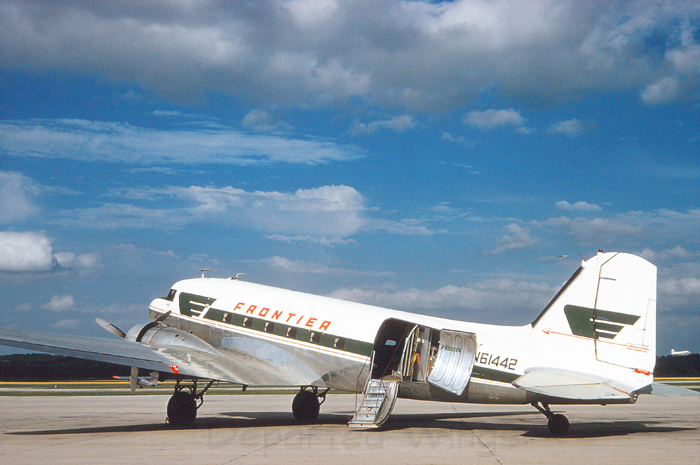 The Douglas DC-3
variant was the foundation of the Frontier Airlines
fleet when flights started in June 1950. Seen
parked on the ramp and awaiting loading at Omaha Municipal Airport (OMA)
in July 1959, is N61422 "Sunliner Phoenix," a Douglas
C-47A-30-DL, acquired by Frontier in August 1957. This aircraft was
subsequently destroyed in a landing accident at Miles City, Montana on
March 12, 1964. It would be the first fatal accident for Frontier
Airlines.
The Douglas DC-3
variant was the foundation of the Frontier Airlines
fleet when flights started in June 1950. Seen
parked on the ramp and awaiting loading at Omaha Municipal Airport (OMA)
in July 1959, is N61422 "Sunliner Phoenix," a Douglas
C-47A-30-DL, acquired by Frontier in August 1957. This aircraft was
subsequently destroyed in a landing accident at Miles City, Montana on
March 12, 1964. It would be the first fatal accident for Frontier
Airlines.
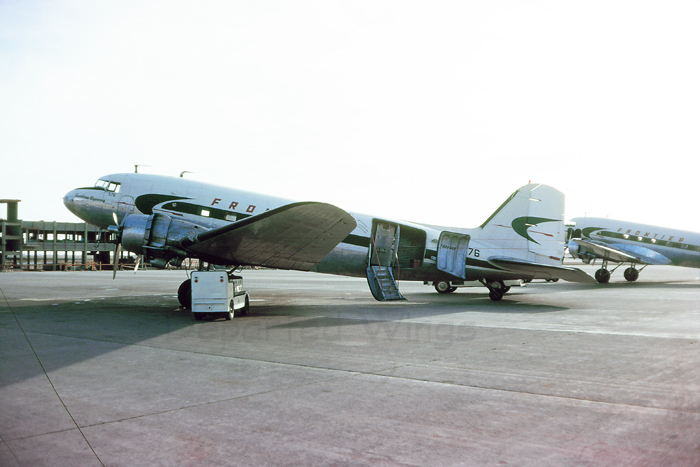 . Wearing the new
arrow and "boomerang" logo, a pair of Douglas DC-3s
sit on the ramp at Denver-Stapleton International Airport (DEN) in June
1964, including this example, N53376 "Sunliner Wyoming," a
Douglas C-47A-80-DL, originally owned by Frontier Airlines predecessor
Challenger Airlines.
. Wearing the new
arrow and "boomerang" logo, a pair of Douglas DC-3s
sit on the ramp at Denver-Stapleton International Airport (DEN) in June
1964, including this example, N53376 "Sunliner Wyoming," a
Douglas C-47A-80-DL, originally owned by Frontier Airlines predecessor
Challenger Airlines.
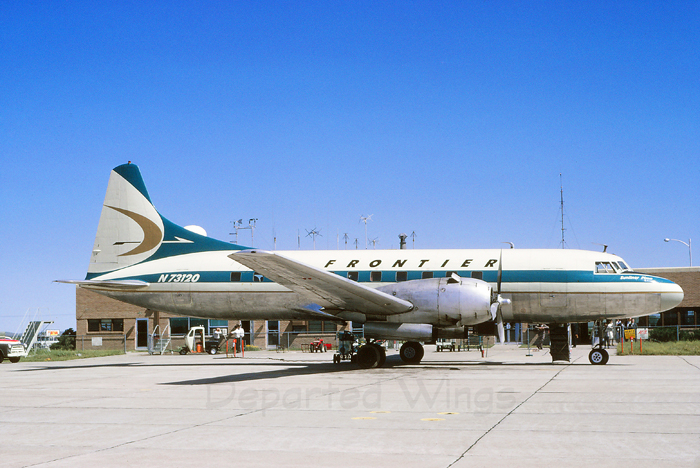 The pressurized
Convair CV-340s were introduced to the Frontier fleet in July 1959
increasing speed and capacity on popular routes. Seen parked in front of
the terminal wearing updated the updated color scheme and awaiting
passengers at North Platte Field (LBF) in June 1964, is N73120 "Sunliner
Pima," a Convair CV-340-31, purchased from United Air Lines a year
earlier in August 1963.
The pressurized
Convair CV-340s were introduced to the Frontier fleet in July 1959
increasing speed and capacity on popular routes. Seen parked in front of
the terminal wearing updated the updated color scheme and awaiting
passengers at North Platte Field (LBF) in June 1964, is N73120 "Sunliner
Pima," a Convair CV-340-31, purchased from United Air Lines a year
earlier in August 1963.
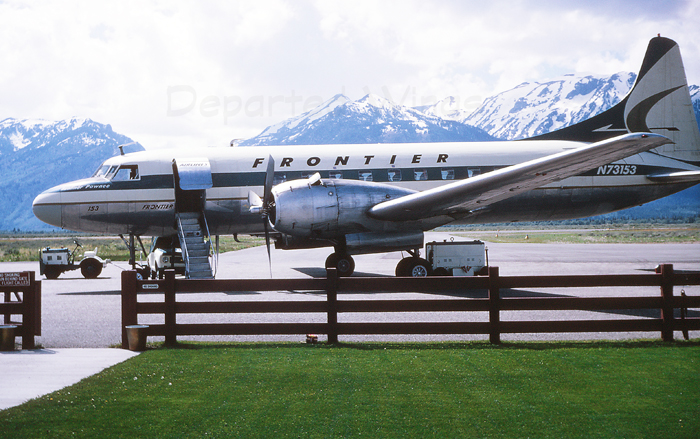 Frontier Airlines
was the first airline to start service into Jackson Hole, a gateway to
the Grand Tetons and Yellowstone National Park. Flights started June 15,
1959 to Denver, Salt Lake City, and Billings using the Douglas DC-3.
Seen parked on the ramp at the picturesque Jackson Hole Airport (JAC) in
June 1965, is N73153 "Sunliner Pawnee," a Convair CV-340-31.
Frontier Airlines
was the first airline to start service into Jackson Hole, a gateway to
the Grand Tetons and Yellowstone National Park. Flights started June 15,
1959 to Denver, Salt Lake City, and Billings using the Douglas DC-3.
Seen parked on the ramp at the picturesque Jackson Hole Airport (JAC) in
June 1965, is N73153 "Sunliner Pawnee," a Convair CV-340-31.
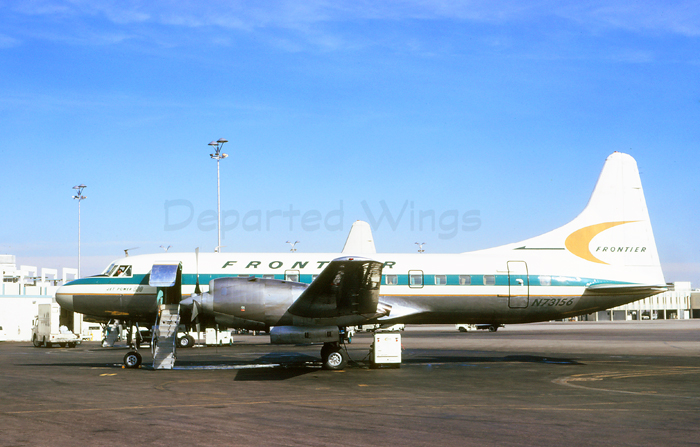 Frontier Airlines
was the first airline to convert the piston-engined Convair CV-340 to
the Allison turboprop powered "580" standard with the first
being delivered in June 1964. Parked on the ramp at Denver-Stapleton
International Airport (DEN) in November 1966, is N73156, a Convair
CV-580, converted in April 1965.
Frontier Airlines
was the first airline to convert the piston-engined Convair CV-340 to
the Allison turboprop powered "580" standard with the first
being delivered in June 1964. Parked on the ramp at Denver-Stapleton
International Airport (DEN) in November 1966, is N73156, a Convair
CV-580, converted in April 1965.
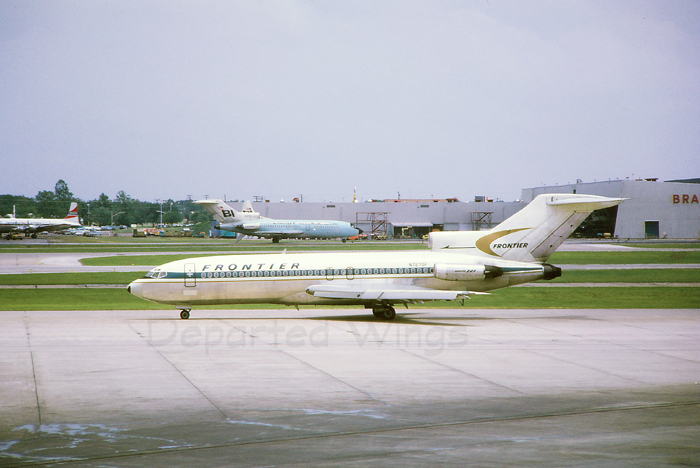 Frontier Airlines
first pure jet was the Boeing 727 first delivered in September 1966.
Seen taxiing at Dallas-Love Field (DAL) in May 1967, is N7270F, a Boeing
727-191, and the first type delivered to the airline on September 8,
1966.
Frontier Airlines
first pure jet was the Boeing 727 first delivered in September 1966.
Seen taxiing at Dallas-Love Field (DAL) in May 1967, is N7270F, a Boeing
727-191, and the first type delivered to the airline on September 8,
1966.
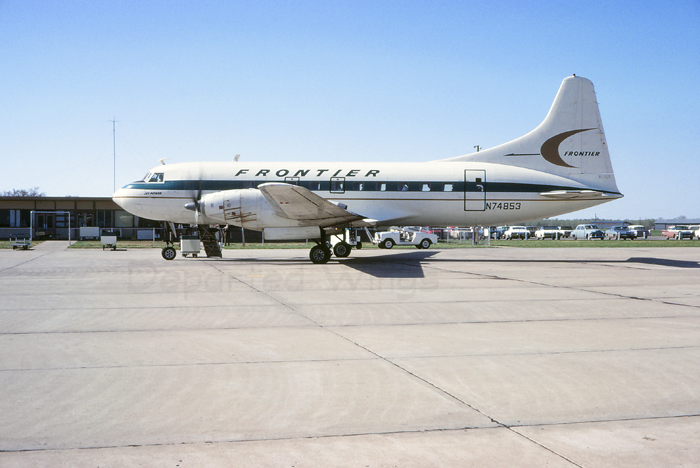 With
the purchase of Central Airlines, Frontier acquired eleven Convair
CV-600s which was a converted Convair CV-240 using Rolls-Royce Dart
turboprop engines. This example, N74853, a Convair CV-600 is painted in
full Frontier colors and is parked on the tarmac at Lincoln Municipal
Airport (LNK) in may 1968.
With
the purchase of Central Airlines, Frontier acquired eleven Convair
CV-600s which was a converted Convair CV-240 using Rolls-Royce Dart
turboprop engines. This example, N74853, a Convair CV-600 is painted in
full Frontier colors and is parked on the tarmac at Lincoln Municipal
Airport (LNK) in may 1968.
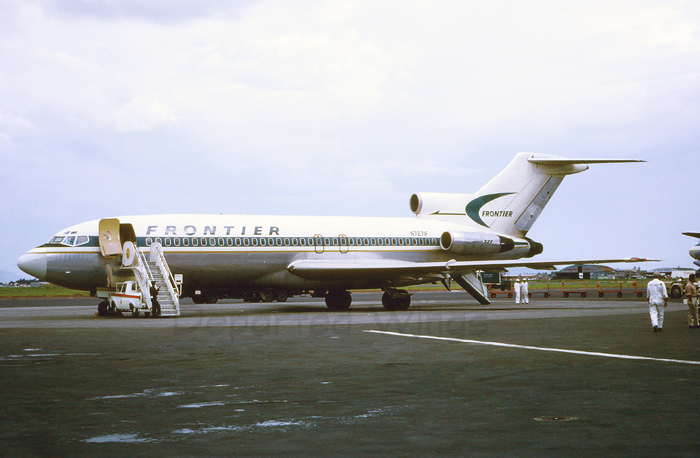 The Frontier
Airlines Boeing 727s were also used extensively for charter operations
throughout North America, such as this example, N7271F, a Boeing
727-191, parked on the ramp at Mexico City International Airport (MEX)
in July 1968.
The Frontier
Airlines Boeing 727s were also used extensively for charter operations
throughout North America, such as this example, N7271F, a Boeing
727-191, parked on the ramp at Mexico City International Airport (MEX)
in July 1968.
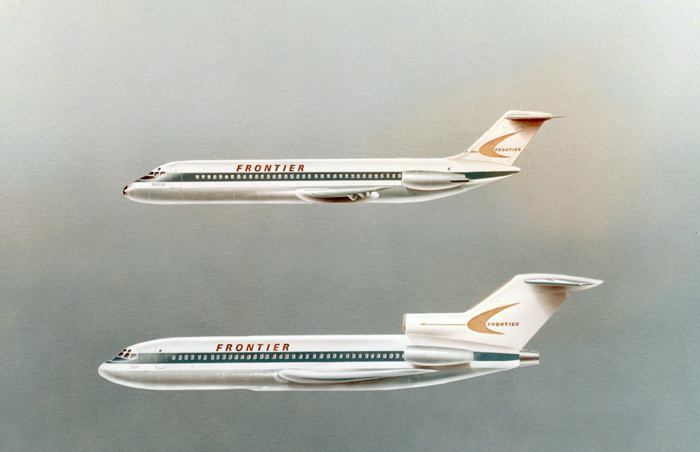 After the delivery
of the Boeing 727s, Frontier Airlines considered other aircraft to feed
the smaller, short-haul routes and had considered the Douglas DC-9
before settling on the Boeing 737. This image was the proposed "two"
plane fleet Frontier considered in the late 1960s with both the Boeing
727 and Douglas DC-9.
After the delivery
of the Boeing 727s, Frontier Airlines considered other aircraft to feed
the smaller, short-haul routes and had considered the Douglas DC-9
before settling on the Boeing 737. This image was the proposed "two"
plane fleet Frontier considered in the late 1960s with both the Boeing
727 and Douglas DC-9.
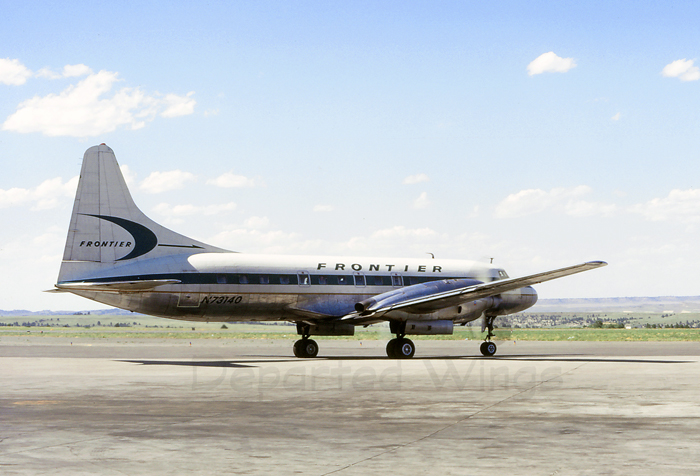 Billings, Montana
service started with predecessor Challenger Airlines in July 1947 and
expanded on September 15, 1954 as part of Frontier Airlines
awarded CAB Williston Basin route authority. Seen taxiing away from the
terminal for an afternoon departure at Billings Logan Field (BIL) in
August 1969, is N73140, a Convair CV-580.
Billings, Montana
service started with predecessor Challenger Airlines in July 1947 and
expanded on September 15, 1954 as part of Frontier Airlines
awarded CAB Williston Basin route authority. Seen taxiing away from the
terminal for an afternoon departure at Billings Logan Field (BIL) in
August 1969, is N73140, a Convair CV-580.
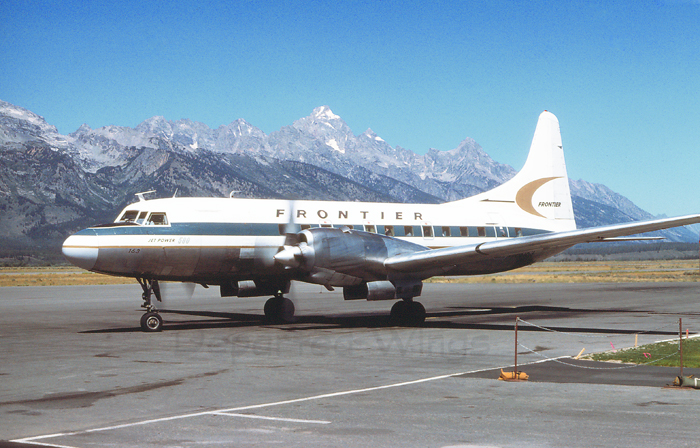 Conavir
CV-580 "Jet-Prop" flights replaced the Convair CV-340 flights
into Jackson Hole in 1964, as the new, powerful turboprops made
operations at the 6,400 foot-elevation airport much easier. Seen taxiing
away from the terminal ramp for a mid-morning departure at Jackson Hole
Airport (JAC) in August 1969, is N73163, a Convair CV-580.
Conavir
CV-580 "Jet-Prop" flights replaced the Convair CV-340 flights
into Jackson Hole in 1964, as the new, powerful turboprops made
operations at the 6,400 foot-elevation airport much easier. Seen taxiing
away from the terminal ramp for a mid-morning departure at Jackson Hole
Airport (JAC) in August 1969, is N73163, a Convair CV-580.
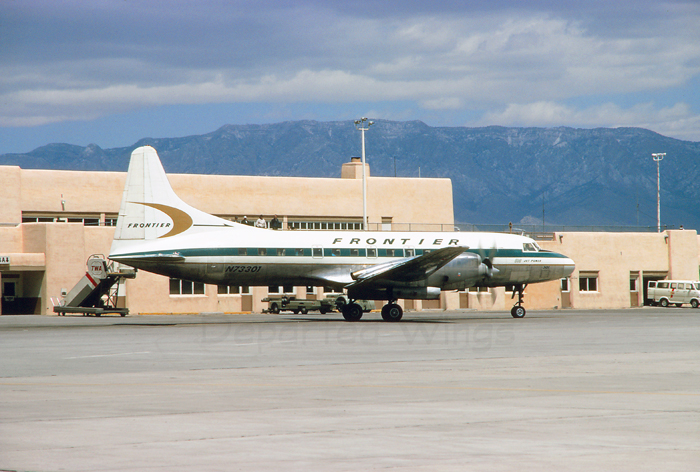 Service
to New Mexico started with Frontier Airlines predecessor Monarch
Air Lines in 1946, on a route between Albuquerque and Farmington
continuing to Denver. By 1970, Frontier was serving five locations in
the "Land of Enchantment," and was operating multiple daily
flights from Albuquerque. Seen about to taxi away from the terminal for
an afternoon departure at Albuquerque International Airport (ABQ) in
April 1970, is N73301, a Convair CV-580.
Service
to New Mexico started with Frontier Airlines predecessor Monarch
Air Lines in 1946, on a route between Albuquerque and Farmington
continuing to Denver. By 1970, Frontier was serving five locations in
the "Land of Enchantment," and was operating multiple daily
flights from Albuquerque. Seen about to taxi away from the terminal for
an afternoon departure at Albuquerque International Airport (ABQ) in
April 1970, is N73301, a Convair CV-580.
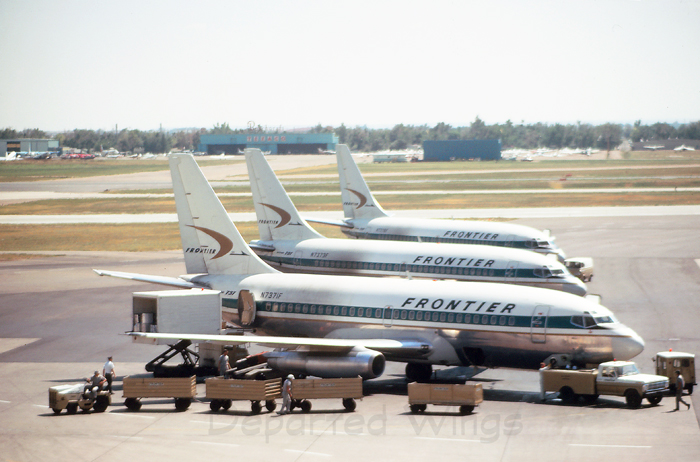 Frontier Airlines
received its first Boeing 737-200 in May 1969, and it soon found popularity
amongst employees and passengers. A trio of new Boeing 737-2COs,
including N7371F, N7373F, and N7376F sit on the ramp and are being
serviced for their next departures at Denver Stapleton International
Airport (DEN) in September 1970.
Frontier Airlines
received its first Boeing 737-200 in May 1969, and it soon found popularity
amongst employees and passengers. A trio of new Boeing 737-2COs,
including N7371F, N7373F, and N7376F sit on the ramp and are being
serviced for their next departures at Denver Stapleton International
Airport (DEN) in September 1970.
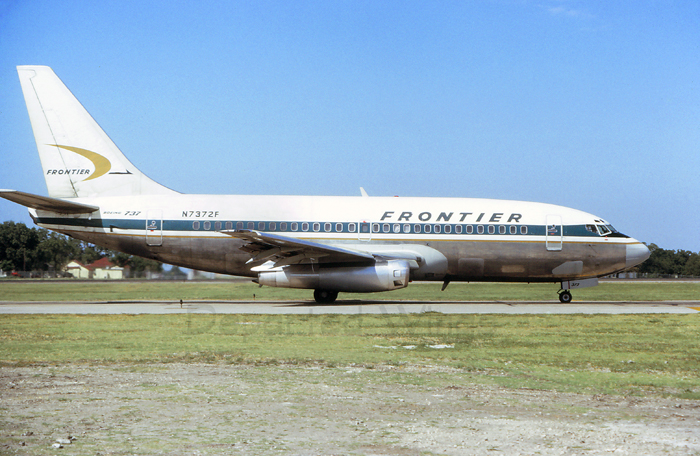 Dallas saw early
Frontier service with both the Boeing 727 and Boeing 737s as it was a
major hub with the old Central Airlines system. Seen taxiing at
Dallas-Love Field (DAL) during a warm summer day in June 1971, is
N7372F, a Boeing 737-2CO, delivered new to the airline on March 4, 1969.
Dallas saw early
Frontier service with both the Boeing 727 and Boeing 737s as it was a
major hub with the old Central Airlines system. Seen taxiing at
Dallas-Love Field (DAL) during a warm summer day in June 1971, is
N7372F, a Boeing 737-2CO, delivered new to the airline on March 4, 1969.
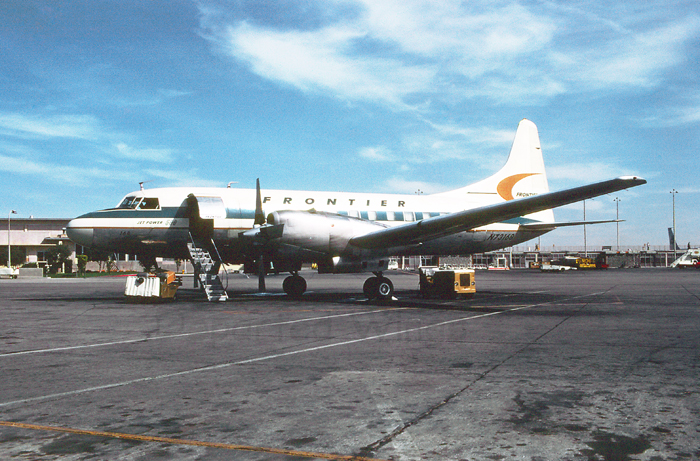 Phoenix was the
base of predecessor airline Arizona Airways which was merged to become
Frontier Airlines in June 1950. Frontier continued to serve Phoenix, and
by 1972 was providing flights from Phoenix to Flagstaff, Tucson, and
Silver City, New Mexico using the "Jet-Power 580." Parked on
the ramp and awaiting another load of passengers at Phoenix Sky Harbor
International Airport (PHX) in March 1972, is N73168, a Convair CV-580.
Phoenix was the
base of predecessor airline Arizona Airways which was merged to become
Frontier Airlines in June 1950. Frontier continued to serve Phoenix, and
by 1972 was providing flights from Phoenix to Flagstaff, Tucson, and
Silver City, New Mexico using the "Jet-Power 580." Parked on
the ramp and awaiting another load of passengers at Phoenix Sky Harbor
International Airport (PHX) in March 1972, is N73168, a Convair CV-580.
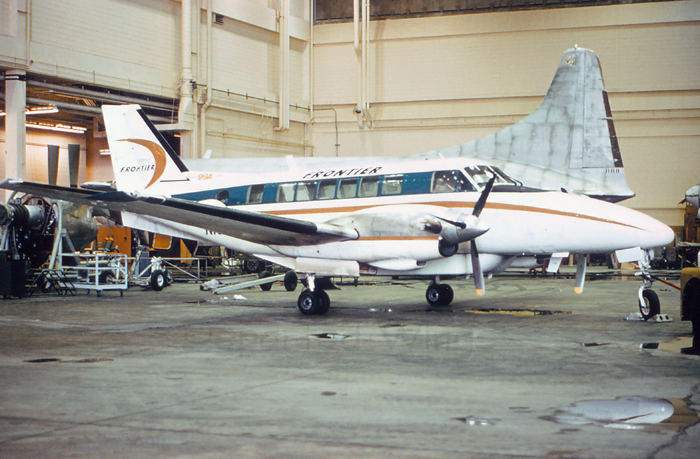 Frontier Airlines
added two Beechcraft B-99 turboprop in 1971 to replace the Convair
CV-580 on service to smaller communities in western Kansas and Nebraska.
Seen parked inside the Frontier hangar and undergoing maintenance at
Denver Stapleton International Airport (DEN) in May 1972, is N20FW, a
Beechcraft B-99A
Frontier Airlines
added two Beechcraft B-99 turboprop in 1971 to replace the Convair
CV-580 on service to smaller communities in western Kansas and Nebraska.
Seen parked inside the Frontier hangar and undergoing maintenance at
Denver Stapleton International Airport (DEN) in May 1972, is N20FW, a
Beechcraft B-99A
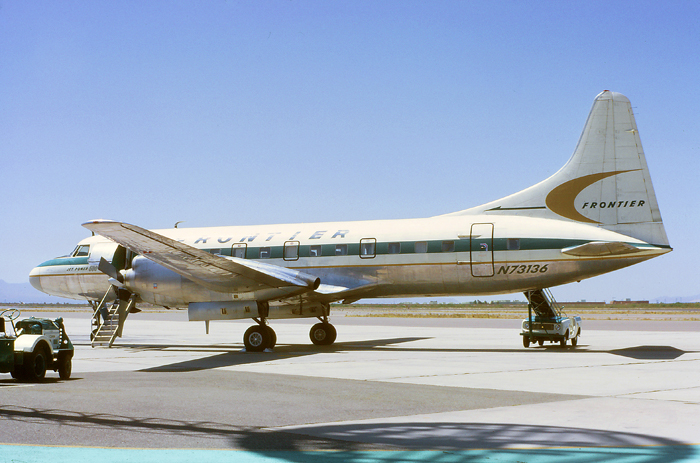 Frontier Airlines
continued to serve Tucson, Arizona, a hold over from the former Arizona
Airways and used Convair CV-580s on services to Albuquerque, Phoenix,
and Silver City. Parked on the ramp during a summer turnaround at Tucson
International Airport (TUS) in July 1973, is N73136, a Convair CV-580.
Frontier Airlines
continued to serve Tucson, Arizona, a hold over from the former Arizona
Airways and used Convair CV-580s on services to Albuquerque, Phoenix,
and Silver City. Parked on the ramp during a summer turnaround at Tucson
International Airport (TUS) in July 1973, is N73136, a Convair CV-580.
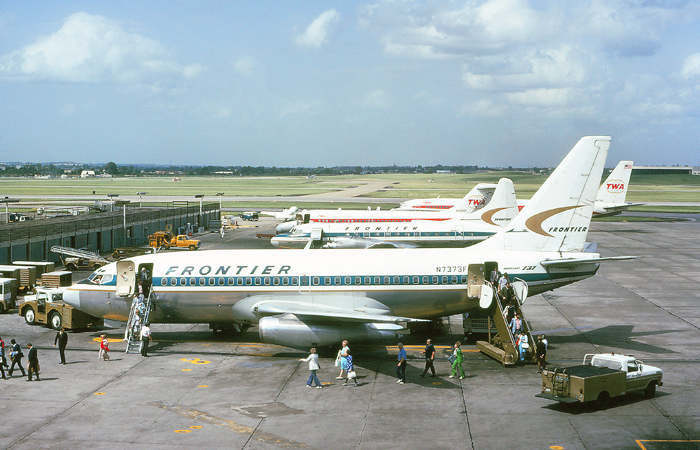 Frontier airlines
started service into St. Louis in June 1967, with the airport becoming a
major point for connections heading west on the Frontier system. Parked
on the ramp at the Red Concourse and unloading passengers at Lambert-St.
Louis International Airport (STL) in June 1974, is N7373F, a Boeing 737-291.
Frontier airlines
started service into St. Louis in June 1967, with the airport becoming a
major point for connections heading west on the Frontier system. Parked
on the ramp at the Red Concourse and unloading passengers at Lambert-St.
Louis International Airport (STL) in June 1974, is N7373F, a Boeing 737-291.
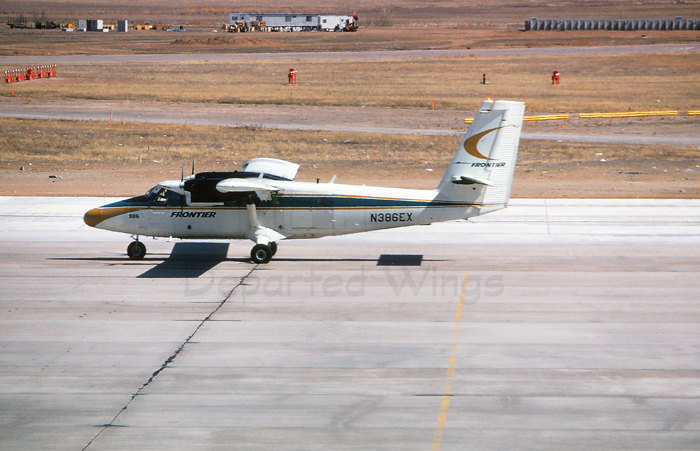 To better serve
smaller airports in the Montana and North Dakota regions, Frontier
purchased a pair of de Havilland DHC-6 Twin Otters in 1970. A few years
later, additional Twin Otters were purchased to replace the Beechcraft
B-99 on Kansas and Nebraska services. Seen taxiing out toward Runway 35
Left at Denver Stapleton International Airport (DEN) in March 1975, is
N386EX, a de Havilland DHC-6-300 Twin Otter on lease from Air New
England.
To better serve
smaller airports in the Montana and North Dakota regions, Frontier
purchased a pair of de Havilland DHC-6 Twin Otters in 1970. A few years
later, additional Twin Otters were purchased to replace the Beechcraft
B-99 on Kansas and Nebraska services. Seen taxiing out toward Runway 35
Left at Denver Stapleton International Airport (DEN) in March 1975, is
N386EX, a de Havilland DHC-6-300 Twin Otter on lease from Air New
England.
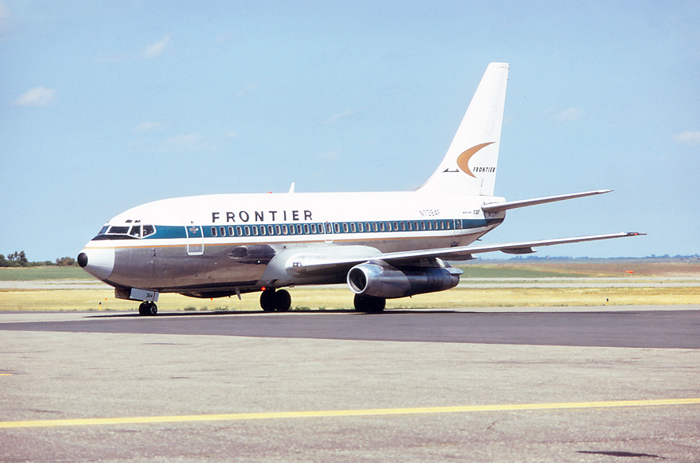 Frontier brought
true jet service to the many communities along the upper Plains during
the 1970s, including Rapid City, Minot, and Bismarck. Seen taxiing
toward the terminal after having landed at Minot International Airport
(MOT) in August 1975, is N7384F, a Boeing 737-247.
Frontier brought
true jet service to the many communities along the upper Plains during
the 1970s, including Rapid City, Minot, and Bismarck. Seen taxiing
toward the terminal after having landed at Minot International Airport
(MOT) in August 1975, is N7384F, a Boeing 737-247.
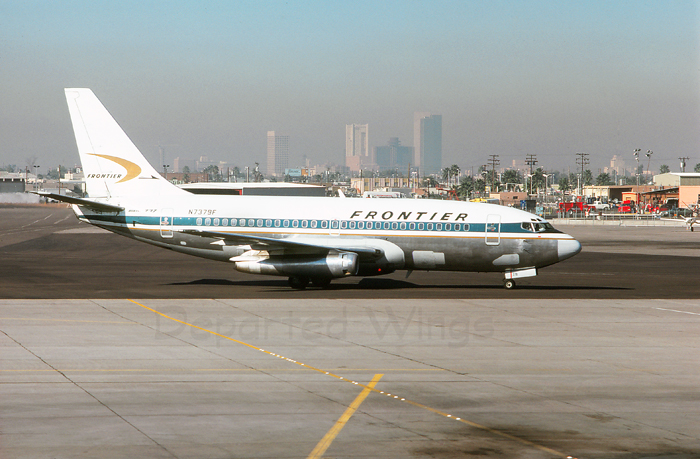 Phoenix, Arizona
continued to be an important destination on the Frontier route map with
no less then seven daily Boeing 737 flights to Denver.
Seen taxiing inbound toward the gate after a morning arrival at
Phoenix-Sky Harbor International Airport (PHX) in December 1975, is
N7379F, a Boeing 737-2C0.
Phoenix, Arizona
continued to be an important destination on the Frontier route map with
no less then seven daily Boeing 737 flights to Denver.
Seen taxiing inbound toward the gate after a morning arrival at
Phoenix-Sky Harbor International Airport (PHX) in December 1975, is
N7379F, a Boeing 737-2C0.
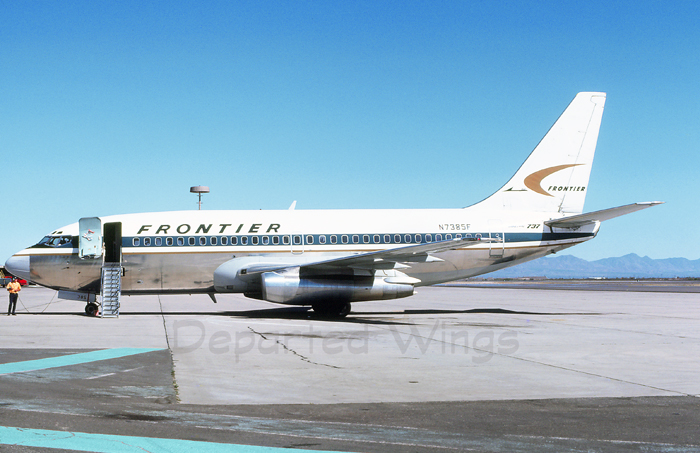 Tucson, Arizona
became strictly "jet" on the Frontier system in 1975 with the
Boeing 737 providing daily service to Albuquerque, Denver, and Phoenix.
Parked on the ramp and awaiting its last passengers before departure at
Tucson International Airport (TUS) in June 1976, is N7385F, a Boeing
737-291.
Tucson, Arizona
became strictly "jet" on the Frontier system in 1975 with the
Boeing 737 providing daily service to Albuquerque, Denver, and Phoenix.
Parked on the ramp and awaiting its last passengers before departure at
Tucson International Airport (TUS) in June 1976, is N7385F, a Boeing
737-291.
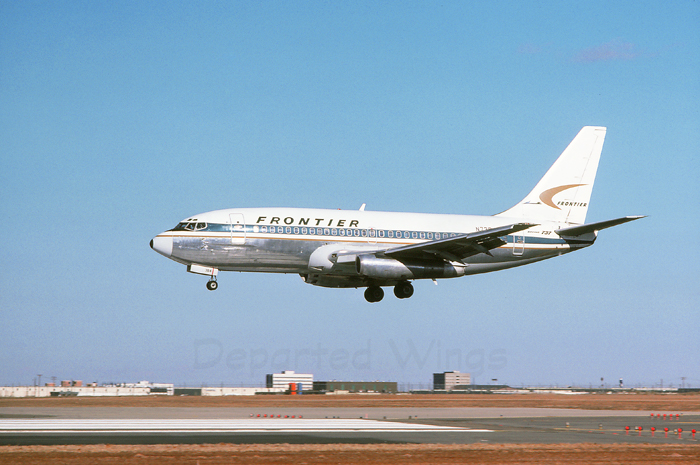 By 1971, the
Boeing 737 had become the sole "turbojet" aircraft in the
Frontier Airlines fleet and would remain this way for over a decade.
Seen over the threshold for Runway 26 Left at Denver Stapleton
International Airport (DEN) on a bright December afternoon in 1976, is
N7384F, a Boeing 737-247.
By 1971, the
Boeing 737 had become the sole "turbojet" aircraft in the
Frontier Airlines fleet and would remain this way for over a decade.
Seen over the threshold for Runway 26 Left at Denver Stapleton
International Airport (DEN) on a bright December afternoon in 1976, is
N7384F, a Boeing 737-247.
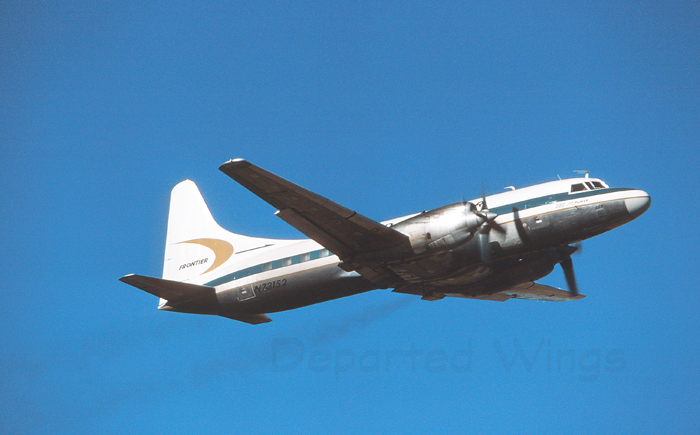 Appropriately
nicknamed the "Mountain Master," for its high power and rugged
flight characteristics especially along the Front Range, N73152, a
Convair CV-580 takes to the skies while departing Denver Stapleton
International Airport (DEN) in January 1978.
Appropriately
nicknamed the "Mountain Master," for its high power and rugged
flight characteristics especially along the Front Range, N73152, a
Convair CV-580 takes to the skies while departing Denver Stapleton
International Airport (DEN) in January 1978.
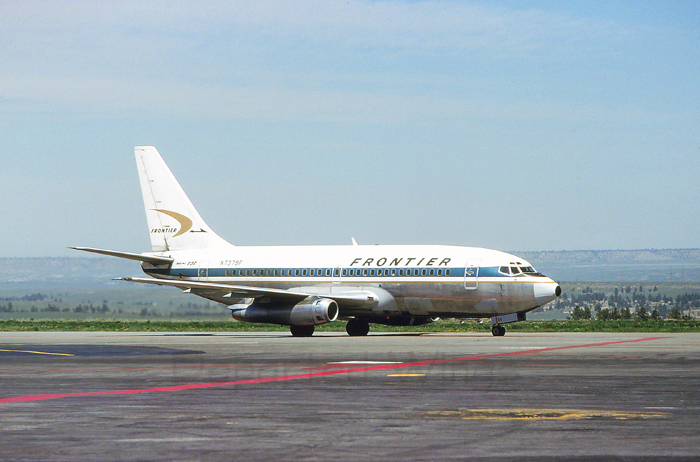 Billings, Montana
became an important "hub" for Frontier Airlines for services to
smaller destinations within Montana and Wyoming. Boeing 737s connected
Billings with Casper, Denver, Great Falls, and Salt Lake City. Seen
taxiing inbound toward the terminal at Billings Logan International
Airport (BIL) in May 1978, is N7379F, a Boeing 737-2C0.
Billings, Montana
became an important "hub" for Frontier Airlines for services to
smaller destinations within Montana and Wyoming. Boeing 737s connected
Billings with Casper, Denver, Great Falls, and Salt Lake City. Seen
taxiing inbound toward the terminal at Billings Logan International
Airport (BIL) in May 1978, is N7379F, a Boeing 737-2C0.
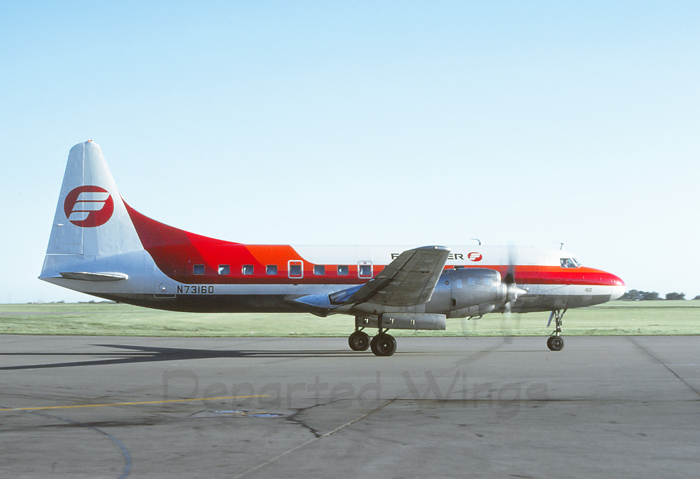 Frontier Airlines
started to see the new Saul Bass design being applied to aircraft
beginning in April 1978. One of the first Convair's to have the
tri-colors applied was N73160, a Convair CV-580 caught taxiing at Kansas
City International Airport (MCI) in June 1978.
Frontier Airlines
started to see the new Saul Bass design being applied to aircraft
beginning in April 1978. One of the first Convair's to have the
tri-colors applied was N73160, a Convair CV-580 caught taxiing at Kansas
City International Airport (MCI) in June 1978.
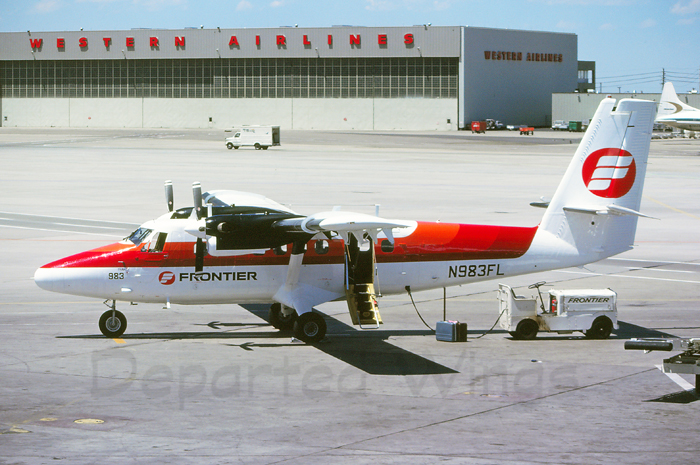 Even the small
fleet of Twin Otters received the new corporate branding starting
including N983FL, a de Havilland DHC-6-300 Twin Otter, delivered to the
airline just a month earlier and seen parked on the ramp at Denver
Stapleton International Airport (DEN) in July 1978.
Even the small
fleet of Twin Otters received the new corporate branding starting
including N983FL, a de Havilland DHC-6-300 Twin Otter, delivered to the
airline just a month earlier and seen parked on the ramp at Denver
Stapleton International Airport (DEN) in July 1978.
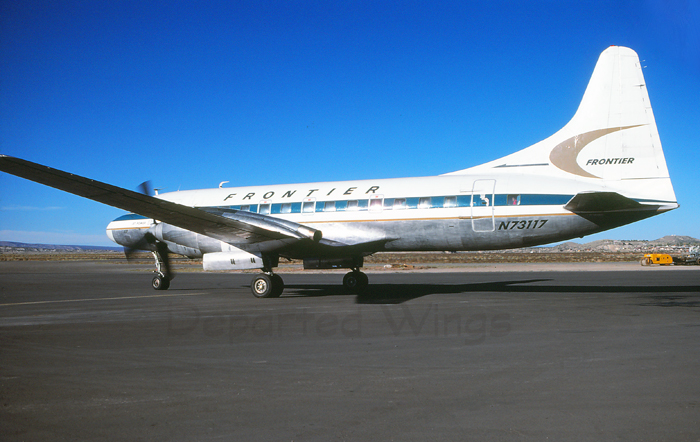 Smaller stations
in the Frontier system continued to benefit from the Convair CV-580s
including Farmington, New Mexico, which had daily service to
Albuquerque, Gallup, Durango, and Salt Lake City. Seen with the Allison
turboprops "spinning-up," and being prepared to depart the ramp
at Four Corners Regional Airport (FMN) in October 1978, is N73117, a
Convair CV-580.
Smaller stations
in the Frontier system continued to benefit from the Convair CV-580s
including Farmington, New Mexico, which had daily service to
Albuquerque, Gallup, Durango, and Salt Lake City. Seen with the Allison
turboprops "spinning-up," and being prepared to depart the ramp
at Four Corners Regional Airport (FMN) in October 1978, is N73117, a
Convair CV-580.
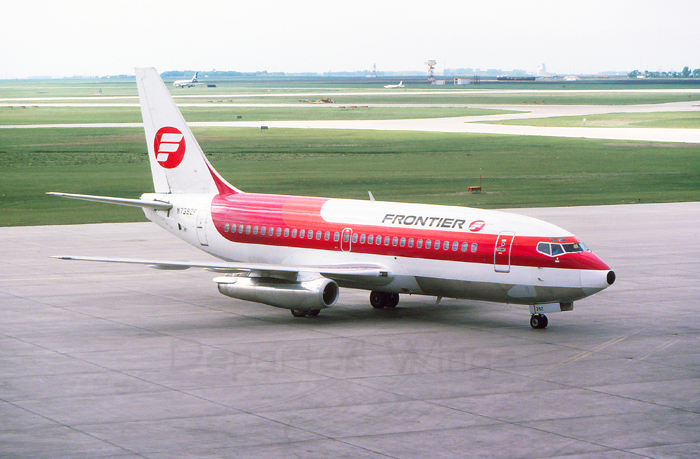 Frontier Airlines
started its first international service on October 28, 1974 when flights
were started between Minot, North Dakota and Winnipeg, Canada. Seeing
taxiing toward its gate at Winnipeg International Airport (YWG) in June
1979, is N7392F, a Boeing 737-291.
Frontier Airlines
started its first international service on October 28, 1974 when flights
were started between Minot, North Dakota and Winnipeg, Canada. Seeing
taxiing toward its gate at Winnipeg International Airport (YWG) in June
1979, is N7392F, a Boeing 737-291.
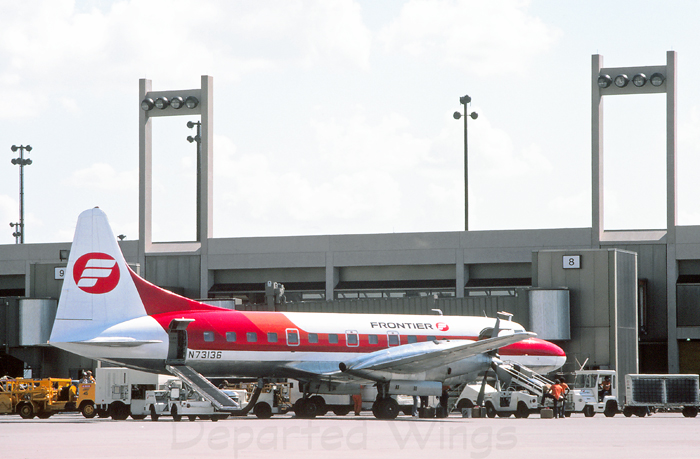 Dallas-Ft. Worth
continued to host the Convair CV-580 turboprop into the late 1970s on
service to only one destination; Fayetteville, Arkansas. Seen parked at
the gate at Terminal 2E at Dallas-Ft. Worth International Airport (DFW)
in July 1979, is N73136, a Convair CV-580.
Dallas-Ft. Worth
continued to host the Convair CV-580 turboprop into the late 1970s on
service to only one destination; Fayetteville, Arkansas. Seen parked at
the gate at Terminal 2E at Dallas-Ft. Worth International Airport (DFW)
in July 1979, is N73136, a Convair CV-580.
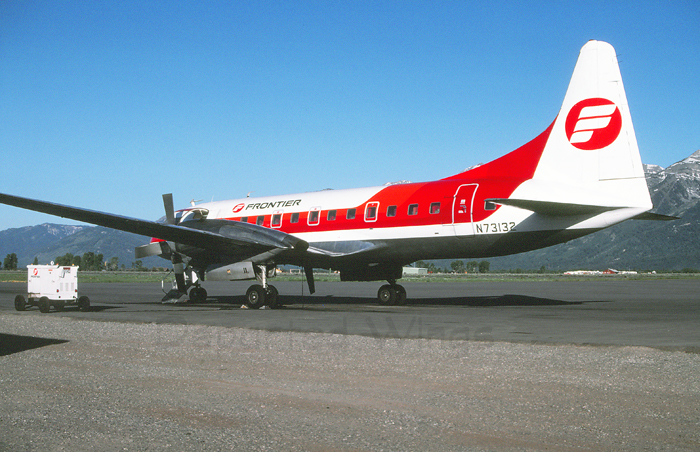 Even by 1979,
Frontier Airlines continued to be the sole scheduled carrier flying into
Jackson Hole, Wyoming with two daily flights; one to Denver and one to
Salt Lake City. parked on the ramp and awaiting boarding at Jackson Hole
Airport (JAC) in September 1979, is N73132, a Convair CV-580.
Even by 1979,
Frontier Airlines continued to be the sole scheduled carrier flying into
Jackson Hole, Wyoming with two daily flights; one to Denver and one to
Salt Lake City. parked on the ramp and awaiting boarding at Jackson Hole
Airport (JAC) in September 1979, is N73132, a Convair CV-580.
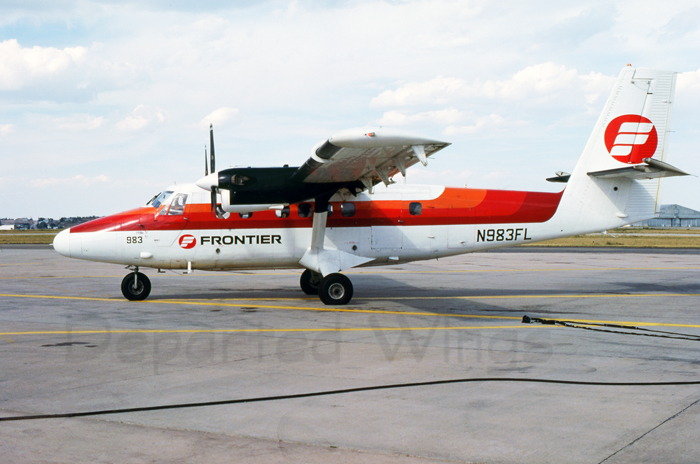 Although the
Twin Otters were providing a service manly to Essential Air Service
(EAS) routes, post-deregulation this became financially difficult. The
Twin Otters would be finally retired in November 1980. Parked on the
ramp and getting ready to taxi away for a quick flight to Denver at
Cheyenne Regional Airport (CYS) in October 1979, is N983FL, a de
Havilland DHC-6-300 Twin Otter, purchased by Frontier in June 1978.
Although the
Twin Otters were providing a service manly to Essential Air Service
(EAS) routes, post-deregulation this became financially difficult. The
Twin Otters would be finally retired in November 1980. Parked on the
ramp and getting ready to taxi away for a quick flight to Denver at
Cheyenne Regional Airport (CYS) in October 1979, is N983FL, a de
Havilland DHC-6-300 Twin Otter, purchased by Frontier in June 1978.
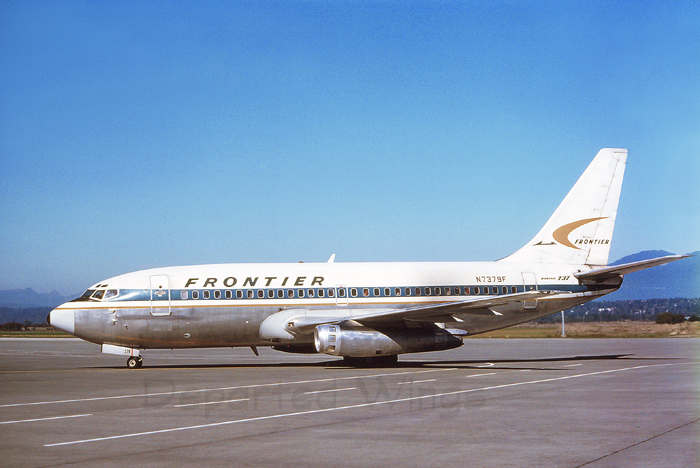 The second
Canadian destination started by Frontier Airlines was Vancouver, British
Columbia with three daily flights to Spokane inaugurated on July 16,
1979. Seen taxiing away from the terminal for a southbound flight at
Vancouver International Airport (YVR) in October 1979, is N7379F, a
Boeing 737-2C0.
The second
Canadian destination started by Frontier Airlines was Vancouver, British
Columbia with three daily flights to Spokane inaugurated on July 16,
1979. Seen taxiing away from the terminal for a southbound flight at
Vancouver International Airport (YVR) in October 1979, is N7379F, a
Boeing 737-2C0.
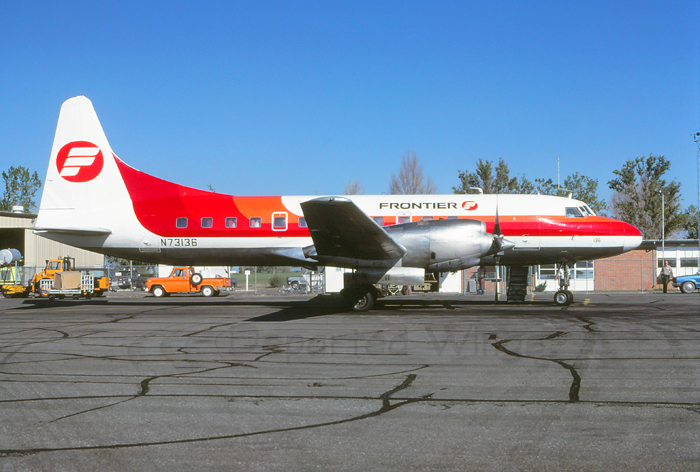 The Convair's
continued to provide service to smaller, secondary destinations across
the Rocky Mountain West such as this example, N73136, a Convair CV-580
awaiting boarding at Worland Municipal Airport (WRL) in October 1979.
The Convair's
continued to provide service to smaller, secondary destinations across
the Rocky Mountain West such as this example, N73136, a Convair CV-580
awaiting boarding at Worland Municipal Airport (WRL) in October 1979.
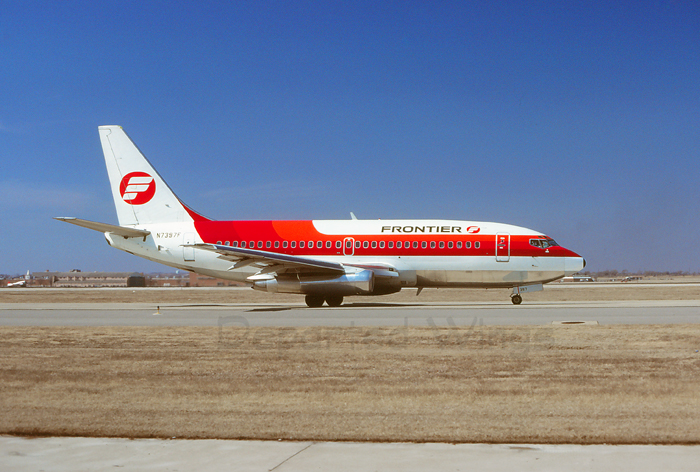 Looking sharp in
the Saul Bass colors, N7397F, a Boeing 737-291, taxis out for departure
at Will Rogers World Airport (OKC), Oklahoma City in March 1980.
Looking sharp in
the Saul Bass colors, N7397F, a Boeing 737-291, taxis out for departure
at Will Rogers World Airport (OKC), Oklahoma City in March 1980.
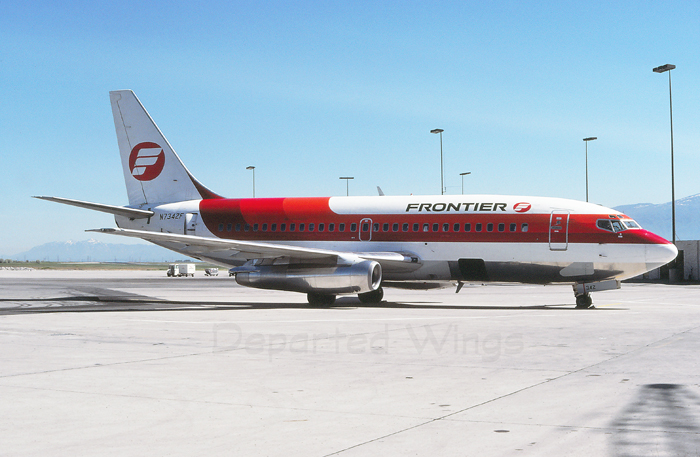 Salt Lake City
continued to be an important destination for Frontier and was the
initial service point for flights to Southern California (Burbank and
Orange County) in 1979. Parked on the ramp during a turn-around at Salt
Lake City International Airport (SLC) in July 1980, is N7342F, a Boeing
737-291.
Salt Lake City
continued to be an important destination for Frontier and was the
initial service point for flights to Southern California (Burbank and
Orange County) in 1979. Parked on the ramp during a turn-around at Salt
Lake City International Airport (SLC) in July 1980, is N7342F, a Boeing
737-291.
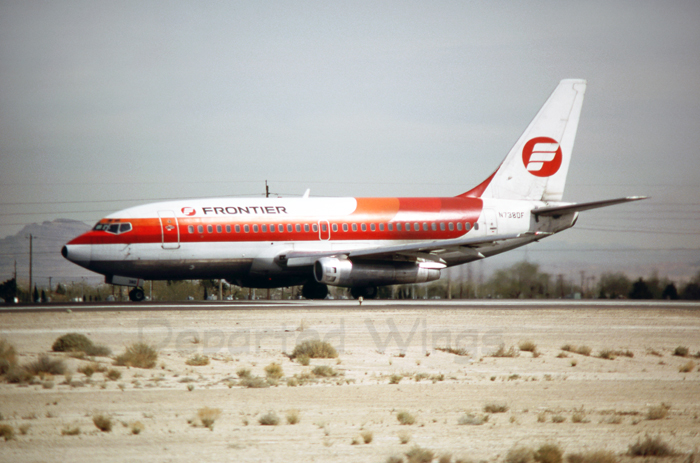 Las Vegas was one
of the first cities to have Frontier Boeing 727 "Arrow Jet"
service when flights were started to Denver on March 1, 1968. Frontier Airlines
continued to serve Las Vegas through it bankruptcy. Seen holding in
position on Runway 25 for an afternoon departure at Las Vegas McCarran
International Airport (LAS) in March 1981, is N7380F, a Boeing 737-214.
Las Vegas was one
of the first cities to have Frontier Boeing 727 "Arrow Jet"
service when flights were started to Denver on March 1, 1968. Frontier Airlines
continued to serve Las Vegas through it bankruptcy. Seen holding in
position on Runway 25 for an afternoon departure at Las Vegas McCarran
International Airport (LAS) in March 1981, is N7380F, a Boeing 737-214.
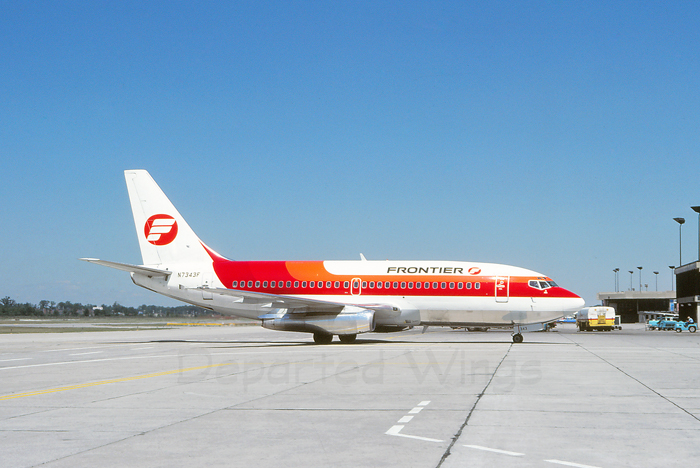 Frontier Airlines
had a checked expansion after deregulation, and expanded slowly
including adding service to Spokane, Eugene, Redding, California,
Detroit, and Toledo during 1979. Seen taxiing in toward the gate after
having landed at Detroit Metropolitan Airport (DTW) in May 1981, is
N7343F, a Boeing 737-291.
Frontier Airlines
had a checked expansion after deregulation, and expanded slowly
including adding service to Spokane, Eugene, Redding, California,
Detroit, and Toledo during 1979. Seen taxiing in toward the gate after
having landed at Detroit Metropolitan Airport (DTW) in May 1981, is
N7343F, a Boeing 737-291.
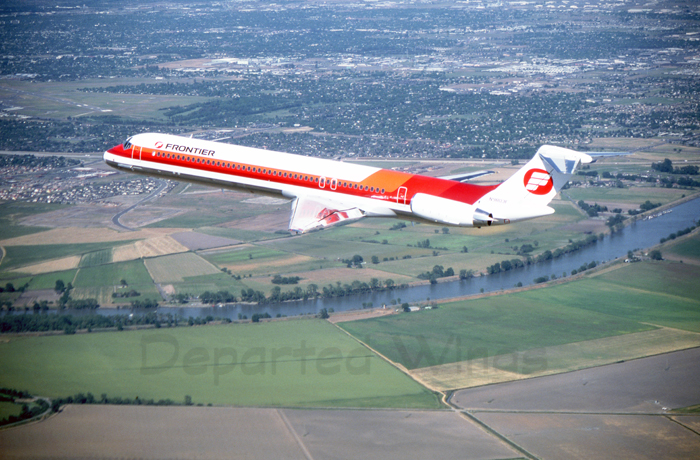 Frontier Airlines
initially ordered three McDonnell Douglas MD-80s (Douglas DC-9 Super 80)
for high-density routes. The first plane was delivered on April 22, 1982
with the other two following a month later. Seen on a pre-delivery test
flight on approach to Sacramento Metropolitan Airport (SMF) in early May
1982 is N9803F, a McDonnell Douglas MD-82, delivered new to the airline
on May 13, 1982.
Frontier Airlines
initially ordered three McDonnell Douglas MD-80s (Douglas DC-9 Super 80)
for high-density routes. The first plane was delivered on April 22, 1982
with the other two following a month later. Seen on a pre-delivery test
flight on approach to Sacramento Metropolitan Airport (SMF) in early May
1982 is N9803F, a McDonnell Douglas MD-82, delivered new to the airline
on May 13, 1982.
 Frontier Airlines
started scheduled passenger operations with the "Super 80" on
May 20, 1982 with a Denver-Las Vegas-Orange County route. Seen being
guided into its parking spot at John Wayne Airport (SNA) Orange County
in June 1982, is N9801F, a McDonnell Douglas MD-82 (Douglas DC-9-82) and
the first example delivered to the airline on April 22, 1982.
Frontier Airlines
started scheduled passenger operations with the "Super 80" on
May 20, 1982 with a Denver-Las Vegas-Orange County route. Seen being
guided into its parking spot at John Wayne Airport (SNA) Orange County
in June 1982, is N9801F, a McDonnell Douglas MD-82 (Douglas DC-9-82) and
the first example delivered to the airline on April 22, 1982.
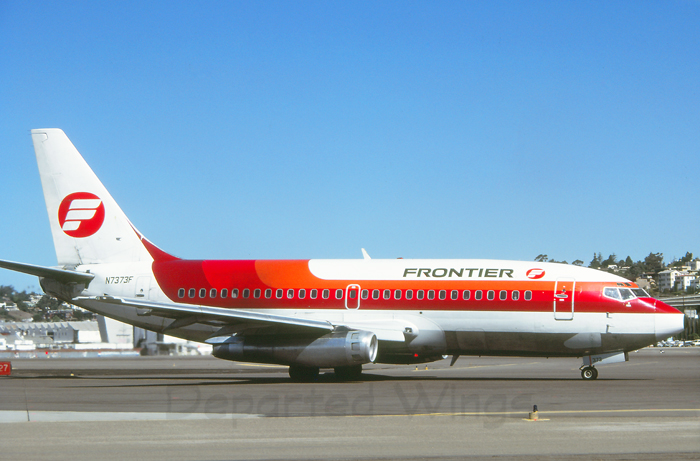 San Diego was
the seventh destination in California Frontier was to add when flights
started to Denver on April 30, 1982. Seen taxing outbound toward Runway
27 for a mid-morning departure at San Diego Lindbergh Field (SAN) in
October 1982, is N7373F, a Boeing 737-291.
San Diego was
the seventh destination in California Frontier was to add when flights
started to Denver on April 30, 1982. Seen taxing outbound toward Runway
27 for a mid-morning departure at San Diego Lindbergh Field (SAN) in
October 1982, is N7373F, a Boeing 737-291.
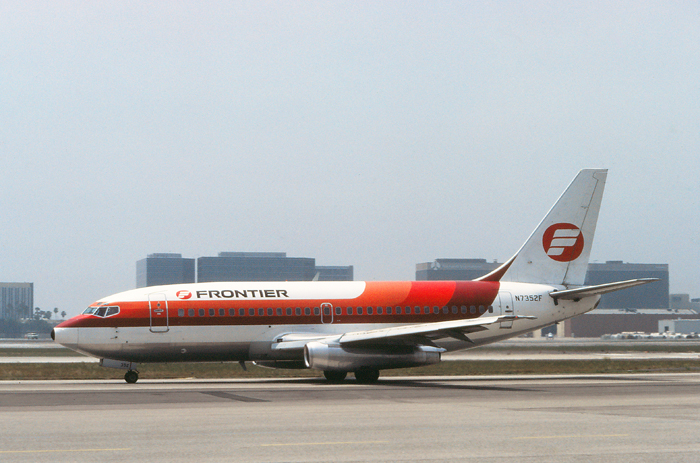 Although
competing with United Airlines, Frontier started service into the
lucrative Los Angeles market with flights to Denver on May 1, 1981. Seen
taxiing toward Runway 25 Right for departure on an overcast morning at
Los Angeles International Airport (LAX) in June 1983, is N7352F, a
Boeing 737-291.
Although
competing with United Airlines, Frontier started service into the
lucrative Los Angeles market with flights to Denver on May 1, 1981. Seen
taxiing toward Runway 25 Right for departure on an overcast morning at
Los Angeles International Airport (LAX) in June 1983, is N7352F, a
Boeing 737-291.
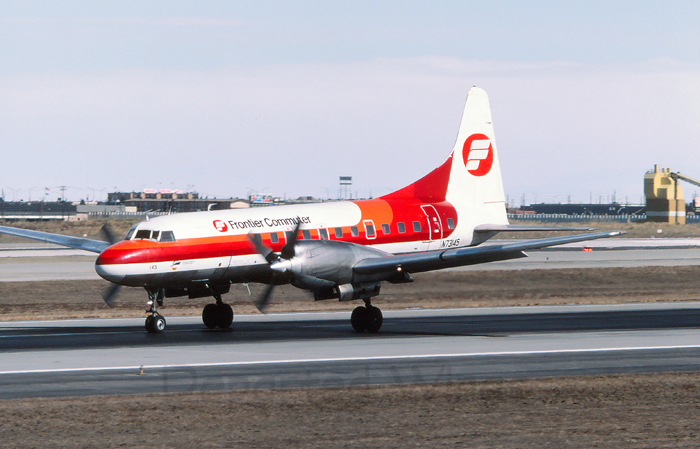 Frontier Airlines
having partnered with Denver based Combs Airways under the "Frontier
Commuter" banner, saw the Convair CV-580 re-introduced on smaller,
regional markets throughout Colorado and Wyoming. Seen having landed and
rolling out on Runway 26 Left at Denver Stapleton International Airport
(DEN) in February 1984, is N73145, a Convair CV-580.
Frontier Airlines
having partnered with Denver based Combs Airways under the "Frontier
Commuter" banner, saw the Convair CV-580 re-introduced on smaller,
regional markets throughout Colorado and Wyoming. Seen having landed and
rolling out on Runway 26 Left at Denver Stapleton International Airport
(DEN) in February 1984, is N73145, a Convair CV-580.
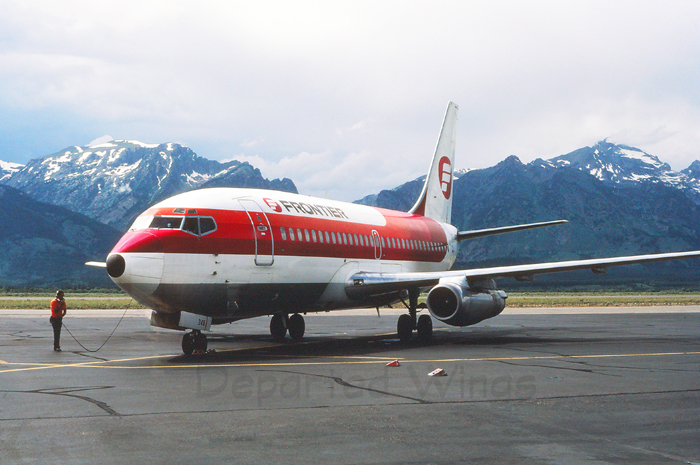 Frontier Airlines
was the first airline to start pure "jet" service into Jackson
Hole Airport when flights were started using the Boeing 737 on June 1,
1981. Seen with the majestic Grand Tetons in the back, and being
prepared to taxi away from the terminal ramp for an afternoon departure
at Jackson Hole Airport (JAC) in July 1984, is N7348F, a Boeing 737-291.
Frontier Airlines
was the first airline to start pure "jet" service into Jackson
Hole Airport when flights were started using the Boeing 737 on June 1,
1981. Seen with the majestic Grand Tetons in the back, and being
prepared to taxi away from the terminal ramp for an afternoon departure
at Jackson Hole Airport (JAC) in July 1984, is N7348F, a Boeing 737-291.
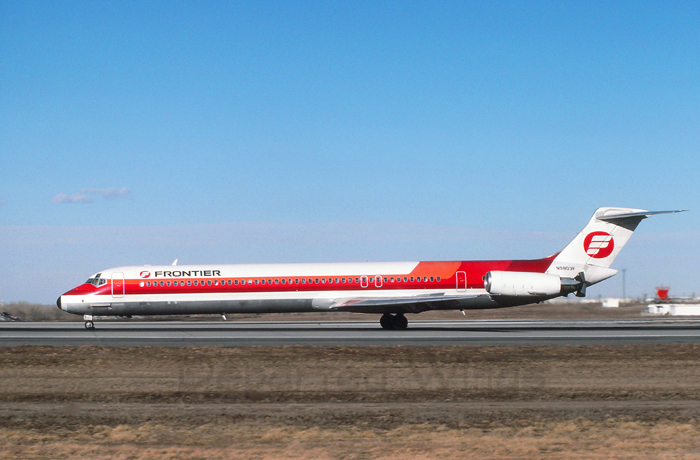 The larger
capacity McDonnell Douglas MD-80s were seen on trunk services to the
West Coast, as well as to Atlanta, and Vancouver, Canada. Seen in
reverse thrust rolling out on Runway 26 Left at Denver Stapleton
International Airport (DEN) in December 1984, is N9803F, a McDonnell
Douglas MD-82 (Douglas DC-9-82).
The larger
capacity McDonnell Douglas MD-80s were seen on trunk services to the
West Coast, as well as to Atlanta, and Vancouver, Canada. Seen in
reverse thrust rolling out on Runway 26 Left at Denver Stapleton
International Airport (DEN) in December 1984, is N9803F, a McDonnell
Douglas MD-82 (Douglas DC-9-82).
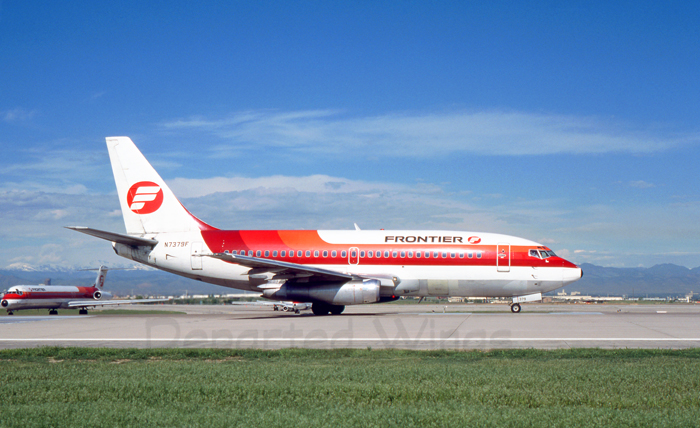 By 1985 in a
cost cutting measure Frontier Airlines had sold a number of its Boeing
737s and then leased then back. Seen holding in position for takeoff on
Runway 35 Right at Denver Stapleton International Airport (DEN) in June
1985, is N7379F, a Boeing 737-2C0.
By 1985 in a
cost cutting measure Frontier Airlines had sold a number of its Boeing
737s and then leased then back. Seen holding in position for takeoff on
Runway 35 Right at Denver Stapleton International Airport (DEN) in June
1985, is N7379F, a Boeing 737-2C0.
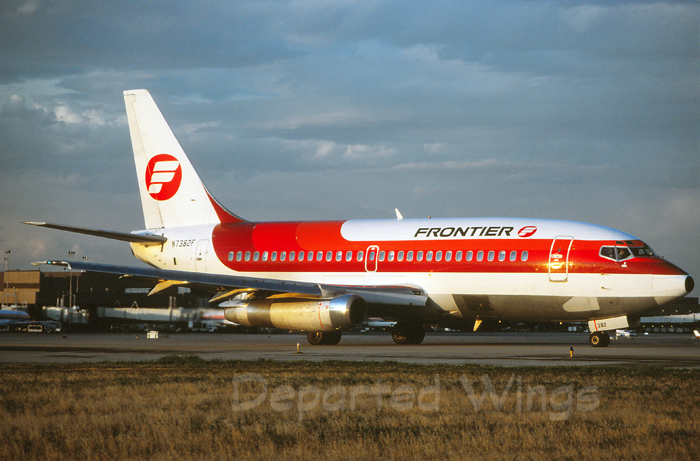 This Frontier
Airlines, N7382F, a Boeing 737-212, captures the last of the setting sun
as it taxis toward Runway 8 Right for an evening departure at Denver
Stapleton International Airport (DEN) in August 1986.
This Frontier
Airlines, N7382F, a Boeing 737-212, captures the last of the setting sun
as it taxis toward Runway 8 Right for an evening departure at Denver
Stapleton International Airport (DEN) in August 1986.
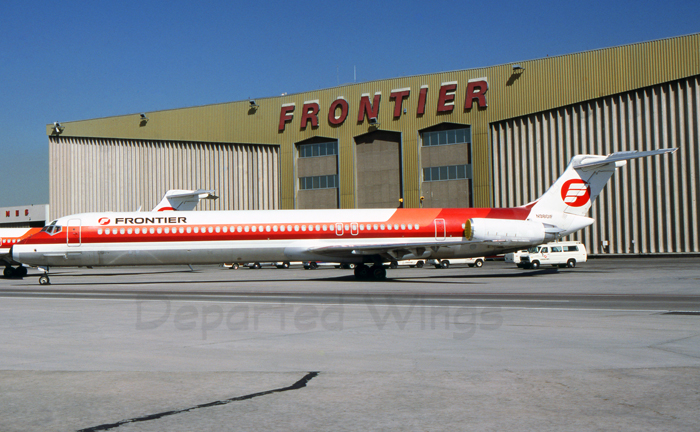 Just weeks after
the shut-down of Frontier Airlines on August 24, 1986 a pair of
McDonnell Douglas MD-80s including N9803F, a McDonnell Douglas MD-82
(Douglas DC-9-82), are parked and "sealed" up on the Frontier
hangar ramp at Denver Stapleton International Airport (DEN) in September
1986.
Just weeks after
the shut-down of Frontier Airlines on August 24, 1986 a pair of
McDonnell Douglas MD-80s including N9803F, a McDonnell Douglas MD-82
(Douglas DC-9-82), are parked and "sealed" up on the Frontier
hangar ramp at Denver Stapleton International Airport (DEN) in September
1986.